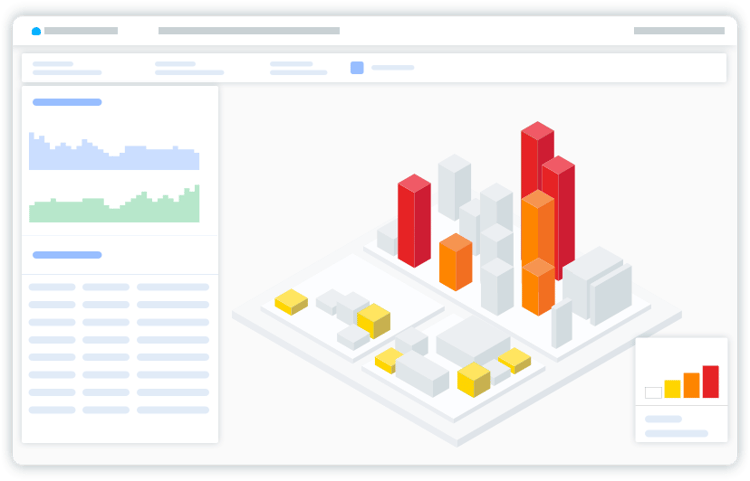
The logistics industry faces great challenges, but even greater opportunities. The globalization of the markets has combined with growing demands from customers and a labor shortage to create a new set of difficulties for an industry already operating with low margins. For those able to successfully construct their metaphorical software factory, software offers a powerful solution. By boosting their efficiency and improving customer experiences, software-affine logistics firms will be able to create a lasting competitive advantage.
In this article, we will discuss the potential for the application of the following technologies:
Automation would offer a solution to one of logistics' biggest problem – the labor shortage. In 2017, nearly three percent of the American workforce was employed in warehouses. Beyond merely reducing labor costs, which would already be a huge win, automation would also reduce processing times. Lower processing times mean greater efficiency and a better experience for customers.
While reducing the labor required, automation can also make the jobs of warehouse employees safer and easier. Automated guided vehicles can move boxes and pallets. So-called swarm robots, such as Amazon's Kiva, move shelving with goods to the picking stations. New devices are able to automate picking and sorting of goods, which strongly improves efficiency. The efficiency in sorting and picking items has become of increased importance in the age of e-commerce, which has caused demand to soar, even as margins for the logistics industry have remained low. Autonomized palletizing robots can apply advanced analytics to determine the optimal location of each box in a pallet. Because the nature of work in warehouses often consists of repetitive actions, it is fertile ground for the application of artificial intelligence and automation.
Within a decade or so, some experts expect to begin seeing fully autonomously operating warehouses. Others, such as Amazon, think it will likely take longer. One of the most daunting challenges to the mission of fully automated warehouses is the required software. Creating a system of interconnected robots operating on some form of artificial intelligence requires a great deal of programming. Unfortunately, this is in and of itself a highly inefficient endeavor, largely due to the inherent complexity and lacking transparency of software development.
So as to satisfy the ever growing demands of customers for transparency and speed in the delivery of their orders, logistics firms should develop digital platforms that integrate the Internet of Things. Such a IoT-integrated digital platform would not only provide customers with a better experience by enabling a more accurate tracking of orders, it would also improve efficiency. For example, a GPS-asset tagging system could be used to optimize delivery routes.
IoT can also be applied in various ways to ensure the safe delivery or storage of goods by monitoring temperature or vibrations. While in the warehouse or being transported, carts or shelves' locations can be tracked to guarantee a successful coordination. This can also be used to improve turnover and reduce idle time. While there are many different applications of IoT, the true power cannot be unleashed without first developing a digital platform or ecosystem to make full use all of the data generated by the IoT devices and sensors. Through this, supply chains would be able to be fully integrated and optimized, minimizing idle time, maximizing turnover, and minimizing storage costs.
For many industries working with logistics companies, such as pharmaceuticals, it is very important to maintain a chain of custody of the goods and guarantee that the goods remain in a certain condition, for example regarding temperatures. In situations such as these as well as others, blockchain can be integrated into the digital platform to provide a greater level of security for the transportation of highly sensitive goods. This would help to protect logistics firms' legal liability.
From automation to IoT to blockchain, the logistics industry is on the precipice of experiencing an influx of new technologies which will only achieve their maximum value capture when combined in some way as a digital platform. Both each part of the digital platform as well as the digital platform itself will require substantial software development. There will be no one standard solution. Logistics companies will be forced to either outsource their IT, risking vendor lock-in, or develop it themselves. Modern software development is highly inefficient and prone to defects and technical debt, making software often a risky investment, especially for companies that are not digital natives. Perhaps this is why many logistics companies have hesitated.
Software Process Mining is a powerful solution for tackling the varied challenges of software production. At the executive level, it provides unparalleled transparency in an intuitively understandable way so that software can aligned with general corporate strategy. For development teams and managers, it provides easily actionable insights and drilldowns so that inefficiencies can be uncovered and quickly removed. Software process mining helps mitigate the risks otherwise inherent to software development. Through this and through the construction of a digital platform, logistics companies of that not-so-distant future shall be able to provide superior customer experiences while also improving their margins by removing inefficiencies.
The acceptance of IT as a core driver of value and support must be strengthened in logistics as well as in big companies at large, so that the interaction between people and technology improves. To achieve this, IT must not be a complex mystery, but must have intuitive interfaces and communication protocols, such as KPIs and software visualizations.

These Stories on News
August-Bebel-Str. 26-53
14482 Potsdam, Germany
hello@seerene.com
+49 (0) 331 706 234 0
Generative AI Seerene GmbH
August-Bebel-Str. 26-53
14482 Potsdam, Germany
hello@seerene.com
+49 331 7062340